We're an affiliate
We hope you love the products we recommend! Just so you know, we may collect a share of sales or other compensation from the links on this page at no additional cost to you. Thank you if you use our links, we really appreciate it!
Many pet parents can recall a scenario when they are sitting in their living room and suddenly, their furbaby starts scooting their bottom across the floor, making them wonder “why do dogs drag their bottom along the floor?”
When dogs drag their butts on the floor or the carpet, also known as “scooting,” most people consider it hilarious or embarrassing behavior as though the dog is doing it for their pleasure.
The truth is, your dog scooting butt behavior means they are feeling irritated and uncomfortable.
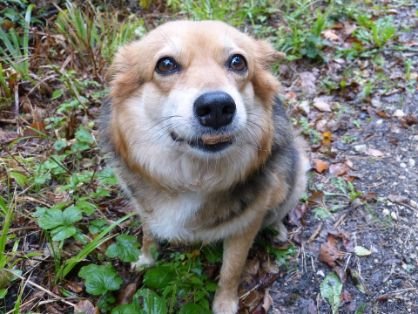
Many pet parents have mistakenly made the impression that scooting is a response to pinworms. When in reality, there are several causes of this behavior, and pinworms are not one of them because dogs cannot be affected by this parasite.
7 Reasons Why Dogs Scoot Their Butt
Many reasons could be responsible for your dog’s scooting behavior, from the mildly uncomfortable to medical reasons.
Knowing the causes of this scooting problem will help lead to more direct resolutions. Read on to find out the reason why your dog is scooting and how to resolve this.
1. Anal Gland Issues
All dogs have their unique scent. Think of it as a smelly fingerprint that can be smelled inside a dog’s two anal glands located inside a dog’s anus. The material secreted from these pea-sized glands is thick, oily, and gives off a fishy-smelling liquid unique for all dogs.
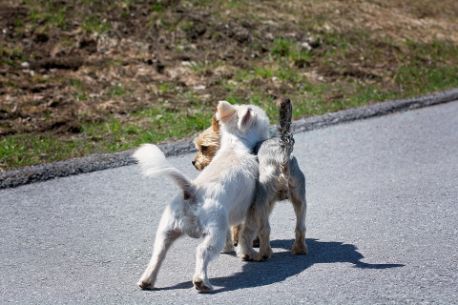
Most wild animals secrete the scent from these glands voluntarily for territorial marking or during self-defense.
On the other hand, domestic pets have lost this ability, and to do so, dogs empty their anal sacs while walking or when relieving themselves.
In most cases, pet parents are not fully aware that their furbaby has emptied their anal sacs, but if you have seen them licking their rear and dragging it across the floor, this may be a cue that they are unable to force the sacs out.
Consult with a veterinarian to determine if the scooting is due to an anal sac issue and to know the proper treatment.
What are the Anal Sac Issues To Look Out For?
Simple Anal Gland Impaction
When you see your furbaby licking its rear and scooting across the floor for the first time, this might be quite alarming. Sometimes a dog is just undergoing a mild, simple anal gland impaction wherein they cannot extract the glands on their own.
You can also assist your furbaby in expressing their anal sac by manually pressing the glands gently to secrete the liquid. If this has been successful, no further treatment may be necessary, but if the problem persists, a visit to the vet may be needed.
Quick Guide to Manual Anal Sac Expression:
1. Gather some moistened tissues, put on latex gloves, and arm yourself with your furbaby’s favorite treats.
2. Place your dog in the shower or a bathtub and make them as comfortable as possible.
3. Pull their tail up gently, then bring a few moistened tissues to cover their anus while using your hand to keep them in place.
4. Using your other hand, feel out for the anal glands located at 5 and 7 o’clock next to your dog’s anus.
5. Once you feel a lump, place your index finger on the outer corner and your thumb directly next to the anus.
6. Gently apply pressure to your index finger while allowing your thumb to open the anus slowly and enable the sac to be emptied. You should feel and hear the liquid hit the moist tissue you’re covering the anus with. It may release some foul smell at this point, and the liquid is most likely yellow or brown.
7. Continue to apply pressure until no more fluid is coming out.
8. Switch and do the same to the gland on the other side.
9. That’s it! You have successfully expressed your furbaby’s anal sac.
Anal Gland Infection
When an anal gland impaction is left untreated, they can form an abscess and become infected. If your furbaby is experiencing this problem, you may see him licking or scooting.
Additional symptoms are that your dog is just not acting themselves like shivering, hiding, or having a tough time sitting down on its bottom.
With the help of your vet, they will confirm that an abscess is present. One or both of the anal glands are difficult to express, and the material is thick and has a pus-like appearance.
A bloody foul-smelling discharge is another symptom of an anal gland infection, and when it reaches this point, treatment needs to be more involved.
Manual expression, antibiotics, and an Elizabethan collar, which looks like a cone, may be necessary to prevent them from licking and biting the infected area.
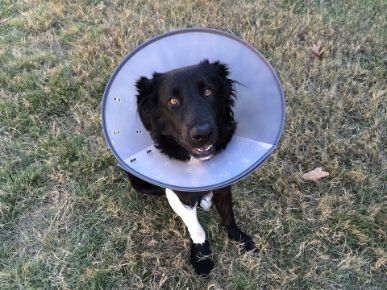
- Anal Gland Rupture
An anal gland rupture happens when one or more anal glands with the abscess are full of pus, causing them to burst, which will eventually leave a draining tract that will form outside the skin.
Symptoms of a ruptured anal gland show similar signs as seen with impaction and infection; however, dogs suffering from this may also give off a pungent, usually bloody, pus-like discharge coming from their bottom.
The affected anal gland will need to be removed surgically, and antibiotics may be infused into it.

Pain medication and an Elizabethan collar may be necessary to prevent your dog from licking and biting the infected area. Both anal gland infections and ruptures will require post-surgery visits to your vet clinic.
How To Prevent Anal Gland Issues?
Some dogs have never experienced any problems with their anal glands, while others may have to visit their vet’s office every few weeks to have them expressed manually.
In this case, adding more fiber to your dog’s diet may be a viable option. Add fiber to your dog’s diet by adding raw vegetables grated in their food, bran, or a fiber supplement in consultation with your vet.

A veterinarian will help decide which option is best. Suppose anal gland issues are still present despite trying recommended treatments; in that case, anal capsulectomy may be suggested. It is the surgical removal of scar tissue that has become thickened and hardened around the anal area.
2. Allergies
If your furbaby still drags their bottom, but their anal glands are delicate, it can be caused by allergies. Dogs with allergies usually have itchy skin brought by two allergens, food, and insect bites.
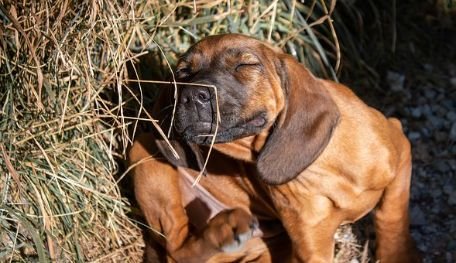
If your furbaby has a food allergy, the remains of that food pass out of their butt, which makes contact with the skin and inflames the mucus membrane around the anus, which brings perianal irritation.
How To Relieve Allergy For Your Dogs?
Follow these tips to treat the allergy so that your dog’s itchy rear becomes a thing of the past.
Hypoallergenic Diet
Since an allergen in your dog’s diet is responsible for the itch, feed them food that does not have this allergen, and all should be back to normal.
This means finding a diet that contains a single protein source and a single carbohydrate source that your dog hasn’t eaten before. Feed this diet to your furbaby for 8–12 weeks and wait for the allergens to clear their system.
Medications
Food allergy doesn’t respond well to anti-allergy meds, but allergy medications should give comfort if those allergens cause skin inflammation.

There are many options available in most pet stores, ranging from cheap drugs with possible side effects to more expensive but safer medicines. Some famous examples are the following:
- Corticosteroids: These are cheap and highly effective anti-inflammatories, but they possess some side effects such as increased thirst, and the risk of developing diabetes or Cushing’s disease.
- Atopica: This medicine is usually used to prevent organ rejection in transplant patients. Its action on the immune system also makes it effective at decreasing the inflammation. It may have a few side effects, including diarrhea or the development of extra gum material.
- Apoquel: This is a safe medication significantly effective at reducing inflammation, which is readily available for those who need it.
3. Diarrhea
We’ve been there before, loose bowel movement, uncomfortable feeling, and an upset stomach. For dogs, additional symptoms for diarrhea can include scooting because of multiple reasons.
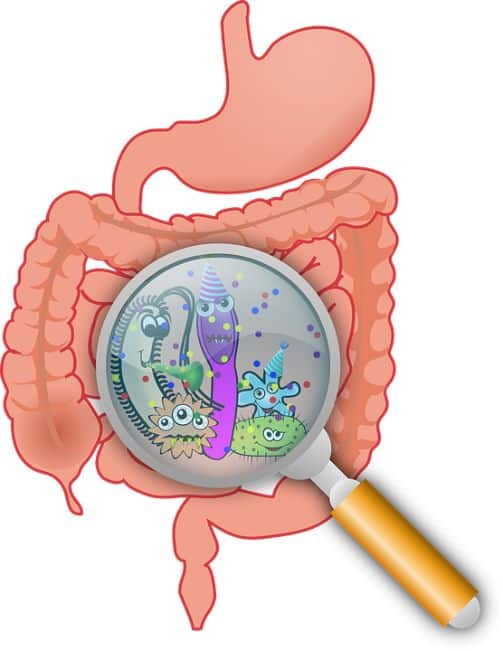
First, the anal sacs don’t get emptied, and that can be irritating and form a build-up. Second, diarrhea can be harsh to the delicate mucus membrane and skin of the anus, making it sore. Since your dog has a hard time to scratch their bottom, they’ll settle for scooting instead.
How To Deal With Your Furbaby’s Diarrhea?
- Diet: If your furbaby is suffering from diarrhea, it is advisable to feed them a bland and easy-to-digest food until his poop firms up. As additional tips, feed little and often, and consider mixing in their meal doggy probiotic.
- Personal hygiene: Keep your furbaby’s bottom clean by rinsing it with weak water after each potty while having diarrhea. You can also apply a germicidal barrier ointment to prevent scorching of the anal sacs.
- See a veterinarian: Diarrhea that doesn’t settle down after 1–2 days needs to be checked immediately by your vet.
4. Dingleberries
Dogs with long fur coats sometimes get their poop stuck, especially in the fur at the bottom area. This stuck poop is called “dingleberries” and can tug their fur that may cause discomfort, or the poop may rub on the skin, which can be painful.

For worse scenarios wherein the dingleberries are stuck so tight that they work as a cork in a bottle and can prevent a dog from pooping. To a dog, scooting is a way to remove this uncomfortable feeling.
How To Deal With Dingleberries?
- Trim: Keeping your furbaby’s hair trimmed at a manageable length, especially in the bottom area, can eliminate dingleberries.
- Personal hygiene: Always check your dog’s rear to make sure they’re clean down there.
- Firm feces: Get diarrhea, or soft stools sorted out quickly so the fur won’t get soiled easily.
5. Parasites
When was the last time your furbaby got dewormed? If it has been too long, it can be why they occasionally scoot their bottom on your floor.

Tapeworms are the most common parasites a dog can have, and it comes from fleas or by eating vermin.
These intestinal worms may cause perianal irritation due to a tapeworm’s ability to lay eggs packets that migrate out of a dog’s anus. These eggs surrounding a dog’s anus can cause discomfort and itchiness.
How To Deal With Parasites?
- If you suspect that your furbaby is affected by tapeworms, look for tiny white seed-like objects near your furbaby’s anus.
- Get in touch with your veterinarian and seek medical help to administer a deworming session. Also, keep in mind that not all dewormers work against tapeworm, so look for one containing praziquantel.
6. Genital Issues
Maybe your furbaby scoot, not because of their bottom, but because of their genitals. General irritation can also occur around your furbaby’s genitals, which can also lead to itchiness and scooting.

How To Deal With Genital Issues?
- For female dogs, check their private parts and note knots in the fur around the vulva, skin infections in the vulval folds, or vaginal discharge.
- If you are unsure of how to check this, visit your veterinarian.
7. Behavioral Issues
And finally: What should you do when your furbaby drags their bottom along the floor?
Never shout at them, because this may just make the problem worse. Giving your dog attention, regardless of positive or negative, rewards the action.
If the dog realizes that scooting makes them the center of attention, they may well use this as a strategy for drawing attention to themselves.
Overall, if your pup drags their bottom once or twice, it is probably just an itch or a dirty bottom after a trip outside.
But if you notice that this behavior has happened more frequently, accompanied by constant licking and biting of the rear area, or any other signs of swelling or abnormality take your furbaby to your veterinarian right away to know the root cause.
We hope that we have answered your question in this article. Has your dog ever done this scooting behavior in your home? What was the cause? Let us know in the comments below!
Laura is the founder of Furs'n'Paws. She is a also a pet writer and expert with more than 20 years of experience of working with dogs and cats. She developed a very strong love for animals at a young age. Her passion led her to establish a thriving pet sitting and dog walking business in Dubai. As an expert in pet training, behavior, and nutrition, Laura is committed to helping pet owners and pet lovers by offering high-quality information on a wide range of topics.


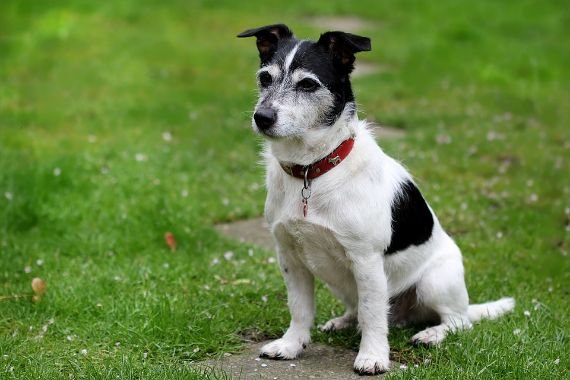
No responses yet